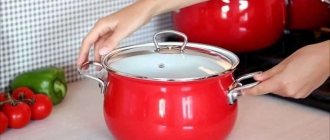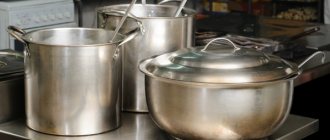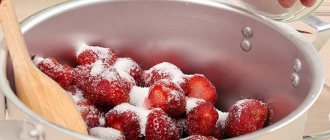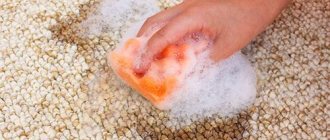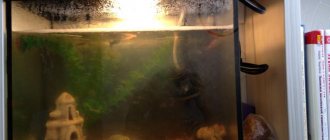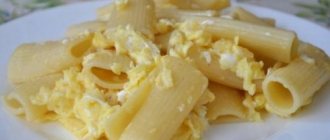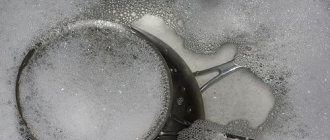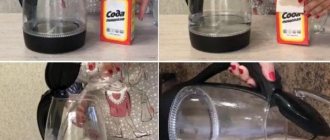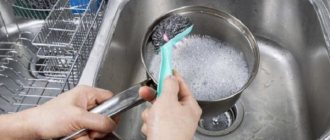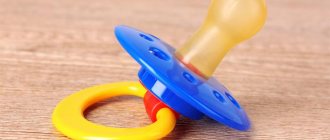How to clean enamel cookware from carbon deposits
Enamel coating is considered the most resistant to mechanical and chemical cleaning methods. But even this is not recommended to be scrubbed with steel wool or other abrasives. The damaged layer of enamel becomes rough, and food particles in scratches begin to burn even faster. Therefore, the pan has to be scraped again, further destroying the coating.
To remove carbon deposits and prevent them from appearing next time, experienced housewives use simple methods using available household substances:
Soda
When lightly moistened with water, sodium bicarbonate powder turns into a delicate abrasive that dissolves and scrapes off carbon particles. If the food is not burnt too badly, then you can clean off the dark marks by simply rubbing the enamel with a chopstick with baking soda sprinkled on it. But for complex stains, you will need to dilute 1 glass of soda in 1 liter of water and leave the pan filled with this solution for 8-10 hours. Then the solution is boiled in it for about 30 minutes and cooled. After this, the carbon deposits are easily washed off, and the residue can be removed by repeated boiling with soda.
Soda Ash
This is a stronger chemical that is often used to clean various surfaces from heavy dirt and burnt grease. It is used in the same way as drinking water, but after using a non-food product, the container must be rinsed well in hot water.
Vinegar
A weak acid dissolves carbon deposits well, making it softer and easier to remove. You can only clean saucepans with intact enamel and no chips with vinegar. Pour a little table vinegar (6-9%) onto the bottom and leave for 1-3 hours. Wash the pan with detergent and rinse well several times to remove the odor.
Activated carbon
This is a good absorbent, but it does not always help. Charcoal is best at cleaning milk deposits. You should crush 10-20 tablets, moisten the bottom of the pan and pour the powder onto the burnt spot. Let stand for about 30 minutes, then pour in warm water and let stand for another 1-2 hours. After this procedure, you just need to wash the pan with a hard sponge.
Bleach or other chlorine bleach
The active ingredient in this chemical is chlorine. It leaves a persistent odor, which you will have to additionally get rid of by boiling clean water. The method is rarely used, only to restore the shiny appearance of kitchen utensils. Pour hot water into the pan and add about 100 ml of chemical for every 5 liters of volume. Leave until cool, then rinse thoroughly and boil.
You need to pour a little table vinegar on the bottom. Baking soda dissolves and scrapes off carbon particles. The active ingredient in bleach is chlorine.
The nuances of removing various food burnt inside from the bottom
Depending on what product is burnt in the pan, you can choose the most suitable processing option.
Sugar containing products
When sweet desserts (baked goods, jam, syrup) burn, it is advisable to use acidic cleaning compounds . If caramel or jam is burnt, you should not leave cleaning the pan for later. First you need to pour high-temperature water into it and let it stand for at least 3-5 hours.
If soaking does not help resolve the issue, the pan should be boiled with a cleaning agent, which is selected based on the material of the dishes.
If the burn from sweet food has hardened and the treatment has not been carried out in time, it will be difficult to clean the pan. You will have to act in several stages, combining soaking, boiling and scrubbing.
Milk
Burnt milk not only spoils the inside of pans, but also has an unpleasant odor. For cleaning, both acids (for example, lemon) and activated carbon or soda can be used.
If boiling milk is carried out frequently, it is recommended to purchase a special pan - a milk boiler . It has a special structure with two layers of walls.
This video will show you how to clean a pan from burnt milk:
Meat, potatoes
If a potato or meat dish is burnt, fill the pan with water as quickly as possible and let it sit. As a result, the deposits will begin to lag behind and can be removed. In order not to damage the surface, cleaning must be carried out in stages, in several passes.
Porridge
Cereals contain a large amount of fiber . This makes it easier to scrape burnt porridge from the bottom of the pan. You should start by soaking the affected bottom and walls. To do this, pour hot water into the container and leave the pan for at least half an hour. In advanced cases, you can try boiling.
Fat
It is not easy to remove burnt fat from a pan. Soaking in this case will not give a clear result. Mustard powder and soda will help deal with fresh soot. To quickly clean a long-burnt pan, it is more convenient to use special household chemicals.
How to clean a burnt aluminum pan
The soft metal aluminum is sensitive to both household chemicals and hard abrasives. When mechanically scrubbing away carbon deposits, its polished top layer is damaged, and micro-scratches appear on the surface. After this, the problem of burning appears more and more often, as with enamel. Aluminum cookware should be cleaned only after preliminary softening of the dark coating.
It is easy to clean the surface with salt and soda. They are taken equally and mixed, and then poured into a pan and slightly moistened to obtain a paste. Keep the dishes like this for 24 hours, and then boil some water in it for 30 minutes. The burnt bottom can be easily washed off after boiling.
Citric acid corrodes burnt protein particles (meat, milk) and makes them easy to wash. Pour some water into the pan and add 1-2 tbsp. l. crystalline acid. Boil for 15-20 minutes and clean with the hard side of the sponge.
Any sour fruit (lemon, apples, cranberries, tomatoes) can replace citric acid. They contain weak fruit acids that will not damage the dishes, but will soften the dark coating on the bottom. Chop the fruits, wrap them in gauze and rub the juice onto the contaminated surface. Leave for 40-50 minutes and then wash off with detergent and a sponge.
Cranberries can replace citric acid. Chop the lemon, wrap in cheesecloth and rub with juice. Apples contain weak fruit acids.
Silicate glue and soda ash are used to clean heavily soiled dishes. You need to boil water in a large container. Add 100 g of glue and soda to 10 liters of boiling water. Place an aluminum pan in the solution and boil for 30-40 minutes. After this, it is quickly washed with a hard sponge.
How to clean a stainless steel pan with a burnt bottom
Stainless steel is not afraid of thermal stress, so dishes that need to be simmered over a fire for a long time are often prepared in a pan made from this material. As a result, food debris often sticks to the bottom and is not so easy to get rid of.
But stainless steel cookware does not require special care: it can be cleaned using almost all standard methods: salt, soda, citric acid, vinegar and other products that any housewife has at home.
The simplest ways:
- Remove all contents from a pan that is burnt and immediately fill it with hot water. Add 2-3 tbsp. l. vinegar and salt, leave overnight. In the morning, a hard sponge will help remove carbon deposits.
- Cover the resulting soot with a layer of salt and leave for two to three hours. If after this time the baked crust remains and does not come off, fill the pan with water and boil its contents over low heat for 30-40 minutes. Then the solution should be left to cool completely for two to three hours, after which the dishes should be thoroughly washed and rinsed.
- You can use baking soda in the same way - sprinkle on burnt food and leave for a while. To speed up the erosion of carbon deposits, you can pour a little lemon juice on the soda. As a result of extinguishing, foam is formed, which loosens the dense structure of burnt food and helps separate it from the wall of the dish.
But the fastest and most effective remedy is activated carbon. It is necessary to crush 4-6 tablets so that they turn into powder, and then scatter it over the entire burnt area. Add some warm water and leave for half an hour. The carbon deposits will come off easily, all you have to do is wash the pan as usual.
How to clean a stainless steel pan from carbon deposits
Stainless steel does not have a protective coating, so the methods used to clean enameled steel pans are not always suitable.
But shiny metal can be washed off from the burn using gentle means:
- Activated carbon. It is used in the same way as indicated for enamel surfaces.
- Soda and soap. A soap-soda solution is prepared from equal parts of soda and soap shavings. You need to take laundry soap. For 1 liter of water, it is enough to take 1 tbsp. l. both ingredients. Dissolve everything in hot water and pour over the burnt pan for several hours. After this, it can be cleaned with a simple sponge.
- Soda ash and office glue. These components are mixed and diluted in water as indicated for cleaning aluminum. The solution can be boiled in a burnt saucepan or cleaned entirely if it is badly damaged.
- Vinegar. It is not advisable to clean stainless steel with vinegar, since the metal is damaged by acid, despite anti-corrosion additives. But if absolutely necessary, this method will also work, if you do not use strong solutions, but limit yourself to apple or table vinegar (up to 6%).
Traditional methods
All recipes are very simple. They are based on the properties of natural substances that are found in every kitchen.
Boiling
The recipe was invented by housewives during Soviet times. At that time, there were practically no household chemicals in stores. Everyone used improvised means.
Inside
The cleaning solution is poured into a stainless steel container. Place it on the burner, heat the liquid to a boil, and simmer over low heat for at least 2 hours. Leave to cool. The solution is drained. Rinse the pan and wipe dry.
Outside
Take a large enamel basin or tank. Fill it with cleaning solution. Place it on the stove. Stainless steel objects are lowered into it. The liquid should completely cover them. The dishes are boiled for at least 2 hours. Remove from the pan when the solution has cooled. All items are washed under running water and wiped.
How to prepare the composition
Take the required volume of water. The working solution is prepared based on the following proportions:
- water - 5 l;
- stationery glue - 100 ml;
- soda - 500 g.
Anti-carbon pastes
There is always a product in the kitchen that can be used to scrub off burnt milk and porridge.
Ground activated carbon
Remains of burnt porridge are quickly removed with activated carbon. The tablets are crushed. Powder is poured onto the bottom of the pan. Pour water into it. After 15 minutes, the carbon deposits are easily wiped off.
Ground coffee beans
Thrifty housewives do not throw away filters with spent coffee. They use grounds instead of body scrub and metal pan cleaner. Apply it to the contaminated area, rub with a sponge, leave for 10 minutes, and rinse with water.
Liquids from white deposits and scale
Scale forms in the kettle, and a white coating forms on the walls of the pan. The cause of deposits is hard water. There are 3 products that can easily cope with this type of pollution.
Citric acid solution
Fill the kettle ⅔ full with water. Add 20 g of citric acid. Boil. Allow the water to cool and boil one more time. Plaque removal begins after a few hours. Scrub with a sponge or brush.
Coca Cola
Fill ⅔ of the pan with the drink. Bring it to a boil. Leave to cool. The plaque is wiped off after 30 minutes. Use a brush or sponge.
How to treat cutlery
Spoons, forks and knives lose their shine over time and contact with food. Restore your radiance using affordable products.
9% vinegar and lemon juice are equally effective. They are applied to cutlery with a flannel napkin. After 30 minutes, rinse and wipe dry.
Ammonia
The lost shine is restored with ammonia. It is added to water - 1 tsp. l/l. The previously washed stainless steel cutlery is lowered into the basin. After 5-10 minutes, rinse spoons, forks, and knives and wipe dry with a kitchen towel.
Non-abrasive toothpaste or powder
The products remove the yellow film and polish the surface. A small amount of paste is applied to the surface and rubbed with a napkin. After rinsing, wipe and rub until shiny with a towel.
Mustard powder
Mustard powder has cleaning properties. It is used to make paste. Stirring constantly, add warm water. The mixture is applied with a brush to the tarnished surface of the stainless steel.
Wear gloves when working with table vinegar. It quickly removes all types of contaminants. Apply it to a soft sponge and wipe tarnished metal surfaces. Durable films of old fat are difficult to remove. To enhance the cleaning effect, add lemon juice to the vinegar. After the procedure, the dishes are rinsed.
Lemon juice solution
Squeeze the juice from half a lemon. For 1 liter of water you need only 1 tbsp. l. Moisten a sponge with the resulting solution and wipe the pan with it inside and out. Rinse it with water and wipe dry with a towel.
Steel Polish
No need to run to the store. An effective polish is available in the kitchen.
Raw potatoes
To make the kettle shine like new, wash the potatoes and cut them into 2 halves. Rub them on a steel surface. Use the same method to shine the pots.
We recommend: How to properly clean a coat at home
How to get rid of burnt jam
Burnt sugar is difficult to remove. The work is simplified by using table vinegar and laundry soap for cleaning. Water is poured into the pan. Pour in soap shavings. Bring to a boil. Remove the pan from the burner. Pour in ½ tbsp. vinegar. When the water has cooled, wipe off the dirt.
How to remove rust
Small rusty areas are removed with baking soda. The surface is moistened with a sponge. Powder is applied to her. After 60 minutes, try to scrub off the rust with a brush. If the result is achieved, the surface is washed with clean water and wiped.
With regular care, stainless steel cookware will not tarnish. Serves for many years, maintaining an attractive appearance and functionality.
Share link:
How to clean a burnt cast iron pan
When washing cast iron, you need to remember that using chemicals is unsafe for health. Simple stains can be easily removed after boiling clean water in a container and letting it cool in the pan.
When cooking rice and burning it in a cauldron, use a mixture of coarse salt moistened with vinegar.
The composition has good abrasive properties and at the same time dissolves some of the burnt starch. The method is suitable for removing the remnants of any flour or sugary food.
Burnt fat can be washed off well with baking soda mixed with soap. The composition is prepared as described above, poured into a cauldron and heated for 30-60 minutes. Then wash with any cleaning product.
Features of cleaning other types of coatings
Modern cookware sometimes has a non-stick coating made of Teflon or ceramic. These surfaces require especially careful handling, because if the coating is damaged, the dishes are considered unsuitable for use. Despite the special properties, food sometimes burns in such containers, and the housewife has to solve the difficult problem of preserving the surface and removing soot.
Teflon cookware
To prevent the formation of burnt spots on Teflon, it is recommended to properly use cookware with such a coating. You cannot heat a non-stick frying pan too hot, otherwise the food on it will not start to burn.
Stains of burnt fat can be easily cleaned with mustard powder. For 1 liter of water take 1-2 tbsp. l. means, pour the mixture into a saucepan or frying pan and boil for several minutes. Then leave for 1 hour. After cooling, the liquid is drained and the carbon deposits are washed off with a soft sponge.
You can wash Teflon with a cleaning gel for acrylic and enamel (Dosya, Sanelit, etc.). They contain surfactants and gentle abrasives that will not damage the coating. If it is heavily soiled, it is recommended to soak the pan in warm water with added cleaning agent.
Ceramic coating
Dishes with a ceramic coating or made from fireproof earthenware can be cleaned using any of the means already given. It can even be subjected to mechanical action of coarse abrasives (fine sand, etc.). But when cleaning, you need to remember the basic rule: never pour water into a hot, scorching pan.
Due to a sharp temperature change, the ceramic or glass-ceramic container will crack, and the coating of these materials on the metal will become covered with microcracks and will soon fail.
Before you start washing the ceramic container, cool it slowly. After this burn stain, you can try to soak it or use acids, soda, mustard, etc.
Methods suitable for all types of pans
When it is difficult to determine what type of material a burnt pan belongs to, universal methods are used that are harmless to any metal or coating. These include:
- Soap and soda solution. For preparation, you can use soda ash or plain soda and gray laundry soap. The ingredients are taken in equal proportions, and the strength of the solution can vary depending on the degree of contamination. Pour the solution into the affected dishes for 1-3 hours, and then wipe off the carbon deposits with a sponge. The method is effective only for protein and fat, but will not help dissolve burnt dough or jam.
- Dissolving the starchy and sugary burnt crust with clean water by boiling for 30-60 minutes. But in case of severe burning, it is better to use acids: weak vinegar or a paste of sour fruits.
- Using washing powder and vegetable oil: pour a little water into a pan, add 3 tbsp. l. oil and add a little powder. Boil for 30-40 minutes, then cool and wipe off stains with a sponge.
Folk remedies for cleaning the burnt bottom of a pan
To clean the pan from carbon deposits, use folk remedies.
| Folk remedy | How to use |
| Salt (not suitable for stainless steel) | 1. Soak the saucepan and remove dirt with a sponge. Dry, sprinkle with coarse table salt for 2-3 hours. 2. Boiling salt solution (dosage depends on the type of surface). |
| Activated carbon tablets | Crush, sprinkle on the stain, wait 40 minutes. Fill the container with water and wait 30 minutes. This method will help remove burnt milk stains. |
| Table vinegar | Fill the bottom of the dish, wait 30 minutes. It will add shine to aluminum and remove blackness. |
| Milk serum | Fill the bottom of the burnt container and wait a day. |
| Silicate glue | Fill a saucepan with water, add 1 tube of silicate glue, place in boiling water for 1-2 hours. Fatty dirt will be removed. Kitchen utensils will shine. |
| Soda | 1. Apply to the stain, wait 30-60 minutes, clean with a sponge. 2. Boiling in a soda solution (dosage depends on the type of surface). 3. Cleaning the surface that has begun to burn, the entire pan. Take a container larger than the original one and prepare a solution (1 pack of soda per 6 liters of liquid). The liquid should cover the saucepan by 2-3 cm. Keep on low heat for 1 hour, remove any remaining burning with a sponge. |
| Sand | It will help to clean the burnt bottom from the outside of the pan. Sand the bottom. |
| Salt+soda | Mix the substances in the same ratio, dilute until a paste forms. Apply to the contaminated area and wait a day. Fill the bowl with water, turn on the burner, put it on the stove, and boil. The method can be used for aluminum and enamel. |
| Liquid soap, dishwashing detergent | Dilute with water, boil for 30-40 minutes. The method is suitable for removing grease stains from silicone molds. |
| Green apple peel, rhubarb, fresh potato peeling | Add one of the indicated products to the water and boil the dishes. Suitable for cleaning enamel from the inside. |
| Dentifrice | Used to remove carbon deposits, replaces an abrasive, does not damage the coating. |
| Citric acid (1 sachet) or lemon juice | Dissolve, boil. A universal remedy that will help remove rice and cereals that have stuck during the cooking process. |
| Soap solution + ammonia | Add a few drops of ammonia to the soap solution. Wait 30 minutes. Remove stains and get rid of burning smell. |
| Laundry soap + PVA glue | Grate ¼ laundry soap, add 1 tbsp. PVA glue. Place in a saucepan filled with water. Boil for 30 minutes. |
| Soda (50 g.), citric acid (bag), “Whiteness” product and water (1 glass each) | Mix the ingredients, pour into a bowl, and wait until it boils. Reduce heat and simmer for 20-30 minutes. |
| Hydrogen peroxide + soda | Mix the ingredients until a paste forms. Cover the contaminated area with the mixture, wait 30-40 minutes, and clean. |
After using these substances, stains are removed with a regular sponge.
After removing the burning, wash and dry kitchen utensils.
Modern chemicals to combat carbon deposits
You can find many modern, effective cleaning products on the shelves of hardware stores. Most often, they are universal, suitable for cleaning any dirt from any dishes. But in order to avoid mistakes and not spoil Teflon or stainless steel, you need to read the instructions on the packaging and find out what kind of cookware the product is suitable for.
Among the general purpose chemicals:
- aggressive preparation Shumanit (for cleaning baking sheets, frying pans, pots and other utensils);
- cleaning products from the Amway product line;
- Sanita gels and powders;
- Sarma dishwashing and cleaning products.
Fairy, Sorti, AOS and other common brands of dishwashing gels are also suitable for removing not too strong deposits.
What not to do when cleaning dishes?
Do not immediately pour water into a hot, burnt pan. In addition to harm to any coating or cast iron and ceramics, such an action can lead to burns from steam or splashes of heated water, hot oil, etc. The dishes need to be cooled, and then immediately begin soaking or cleaning.
It is not recommended to scrape off plaque and carbon deposits with a knife. A metal object leaves deep scratches on aluminum, enamel, cast iron. This cleaning method can completely ruin Teflon dishes. Hard sponges can only be used on abrasive-resistant surfaces (stainless steel, glass and ceramics, cast iron).
Do not clean dishes with chemicals not intended for cleaning food containers. Some substances suitable for cleaning ovens and stoves contain aggressive acids. Using them to clean dishes can be hazardous to health.
